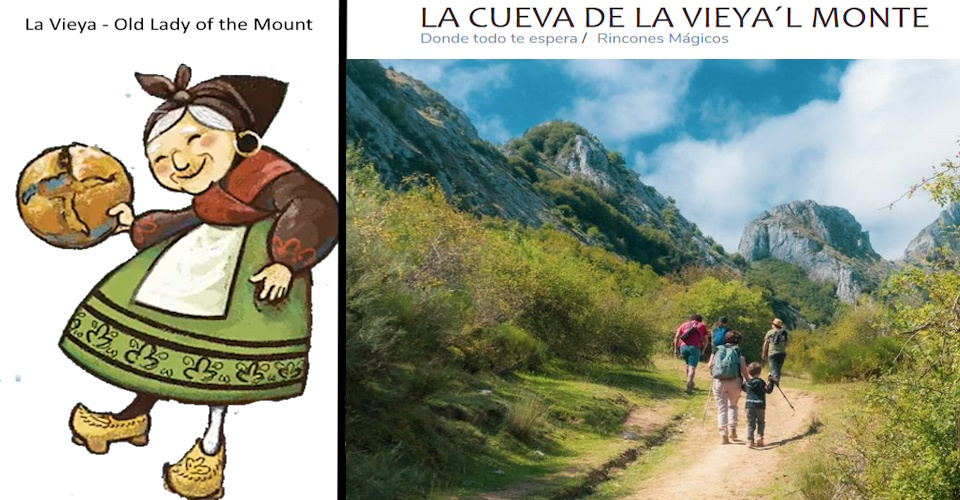Aprons and Stones
Loughcrew, Ireland - Stiperstones, England
Although there are many different versions of the stories about these two places they share similar legends. Loughcrew is high land with prominent hill summits orientated approximately east - west, near Oldcastle, Meath. The Stiperstones is also a high ridge in Shropshire.
Kingship:
The Devil is said to sit on his chair
at the Stiperstones calling together all the unearthly spirits, on
the the night of winter solstice, when the King is chosen for the
following year.
Loughcrew is the legendary resting place of many High Kings of Ireland, the highest place (Cairn T) being the tomb of Ollamh Fodhla, a great king who created the Brehon Laws. Although the Annals of the Four Masters have him buried at Teltown (see Lughnasadh). Ollamh Fodhla's Seat, aka the Hag's Chair, is on the outer kerb of Cairn T.
| White quartzite stones are scattered around the Loughcrew cairns - the hills are also known as Carnbane meaning white cairn. The Stiperstones are made of a unique type of quartzite. |
Hag's Chair / Ollamh Fodhla's Seat |
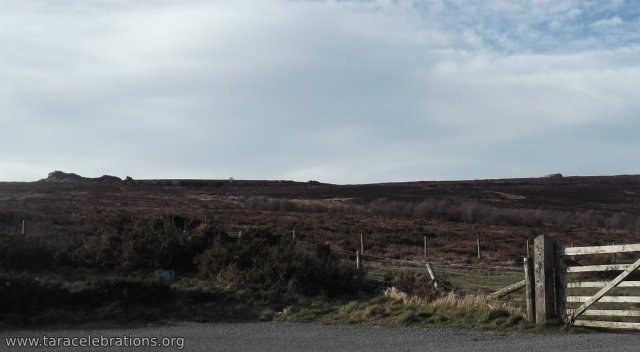
Cailleach:
At both the rocks are said to have fallen from the apron of a
mythical figure.
At Loughcrew it is the old woman, the hag, Cailleach, goddess, who loosens her apron. This is the Cailleach in her role as shaper of the land.
The Stiperstones (photograph of stones on the horizon) legend has it that.... Stiperstones story from Shropshire Star
One of the tors has a particularly creepy tale to tell, and is known for miles around as the Devil's Chair - Shropshire folklore says it was created by Old Scratch himself by accident. "The Devil’s Chair gets its name from folklore: it is said that 'Owd Scratch' was heading back through the hills after spending some time in Ireland. "He carried with him a quantity of large stones, in his apron pocket, which he was planning to use to fill up a valley known as Hell's Gutter, which was not far from the area (alternative versions suggest he was planning to dam the River Severn and flood the whole of Shropshire).
"However, as one can imagine, carrying stones comes with its own set of challenges. It had been a long journey and he was beginning to feel the strain. "Quite suddenly, his apron strings snapped, scattering the stones around him. This infuriated the Devil, and even to this day he is said to jump up and down on the stones, trying to force them back to earth. When he succeeds, it is believed that England will fall.
Carrowmore & Carrowkeel
At the tombs of Carrowmore the Cailleach flew over the region with her apron full of stones, she accidentally dropped them and they scattered across the region. Carrowmore, linked to Carrowkeel, in the Brieklieve Mountains landscape, the name translates as Breac Sliabh, Speckled Mountain; the word speckled can mean many things in old Irish including a magical portal or doorway. Carrowkeel.com and Carrowmore - OPW
| Carrowmore - Tomb 7 | 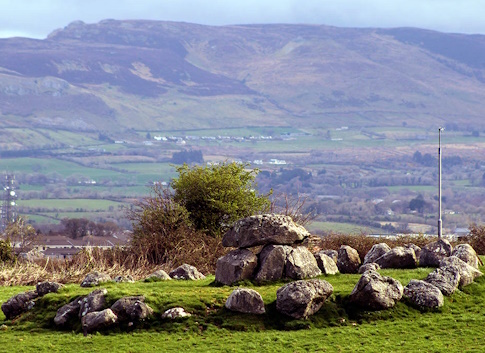 |
The Hag's Chair - Armagh
Known locally as ‘The Hag’s Chair’, the Ballykeel monument is associated with the Cailleach, the mythical goddess of Winter. Legend has it that she would fly down from her home on Slieve Gullion to sit on the dolmen at Ballykeel, which served as her throne. Monumental Ireland - Hag's Chair
| The Hag’s Chair – Ballykeel Dolmen, Co. Armagh |
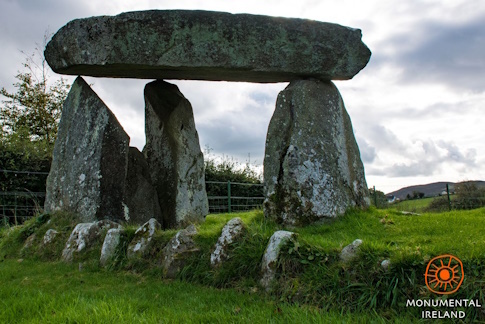
|
And another: Slieve Gullion
There is an eminence in the townland of Knockalough called Slieve Guillion, and a rude stone chair on the summit of Slieve Nacally called Cataoir na Caillige Bera, ie: Calliagh Bera's Chair. It is a large stone, about two tons weight, ornamented with a cross sunk (cut) into the seat of the chair, in which three might sit together. This hollow seems to have been made in the stone with a hammer: the cross is probably the work of a modern stonecutter. The back of the chair was broken by some human enemy to old Evlin. John O'Donovan, 1836
The Devil making a journey, often trying to build a bridge, arises in several legends.
At Seascale in Cumbria it is said that he once tried to build a bridge between there and the Isle of Man. Inevitably, it would seem, his apron split and the stones fell into the sea, bar one. This remains as a rock, Carl Crag, on the shoreline between Seascale and Drigg, with two white seams showing where the apron strings were once wrapped.
Apron Full of Stones is the name of a large cairn, on the eastern edge of Kingsdale Beck, near Ingleton, in the Yorkshire Dales. This limestone area has a scattering of gritstone and sandstone stones. The Devil appears again - he was collecting stones in his apron for a bridge over the River Lune at Kirkby Lonsdale when his apron string broke. The legend goes on to tell how he is duped by an old woman whose soul he desired.
Cormoran and Cormelian | 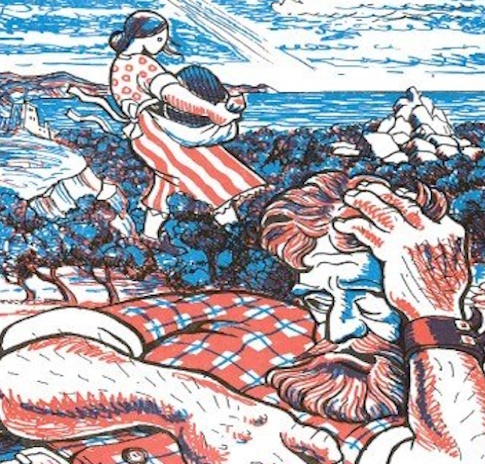 |
St Michael' Mount in Cornwall, south west England, joins in with a similar legend - it is said to have been built by a giant and his wife, Cormoran and Cormelian. They chose granite and Cormelian was forced by her husband to carry the stones in her apron. But wives are bold and when he fell asleep, she decided to change it for a lighter greenstone..... however, he awoke and discovering the deception, he kicked her, her apron strings broke and she dropped the greenstone. A piece of it is still lies on the causeway leading to the Mount.
Pendle Hill in Lancashire has a bad tempered Devil. He wanted to get
rid of the annoying people at Clitheroe Castle (a few miles west). So he
picked up various large stones, put them in his apron then threw them
towards the castle. Not having a great aim most of them missed, which
made him angrier and in a rage he accidentally dropped a great pile of
rocks on the south side of Pendle Hill, creating the Devil’s Apronful on
Apronfull Hill.
In Scotland the Devil wanted to fill at loch
near Ballingry, Fife, with stones. The inevitable happens, the apron
strings break, the stones scatter across the land and the Devil goes
home in a huff.
Anglesey, Wales
Porth Trecastell Bay, a Neolithic passage grave known as Barclodiad y Gawres - the ‘Giantess’s Apronful’.
... there are the carved stones, designs pecked away with a stone chisel: chevrons, spirals and zigzags in a style seen in other Neolithic passage graves across the Celtic Sea in Ireland, or further afield in Brittany and Portugal. Clearly the Neolithic settlers on Anglesey came from voyaging stock. Tish Farrell - and - Picture below from Visit Wales
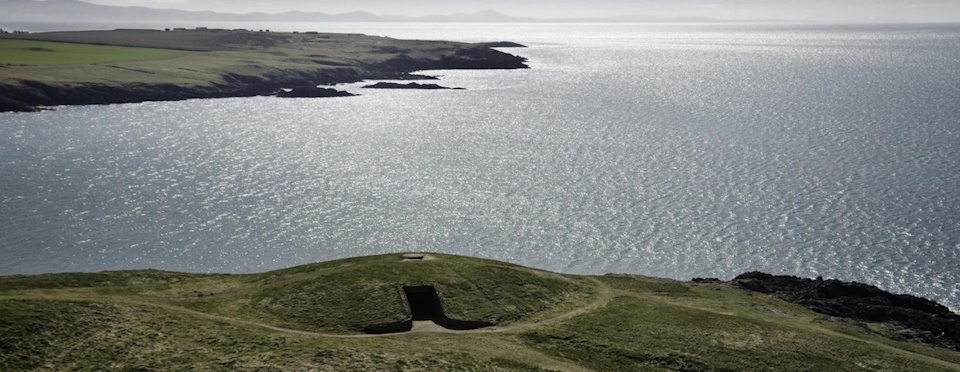
Spanish Connection
From: intarch.ac.uk journal
Cristobo de Milio Carrín has documented an analogous female deity in the mythology of Asturia Galicia, the Basque Country and Brittany. Here she is called la Vieya (The Old One), Mari, or Mouros; but the parallels to the Cailleach Bhérra are unsettling. La Vieya too, lives on top of a mountain and controls the weather. The fate of crops and animals are in her hands, and she is associated with war and with destiny. The Irish and Scottish cailleach often carries a baton or wand, la Vieya brandishes a spinning spindle. And she, too, is credited with making a great number of Neolithic megaliths; in fact the creation myth of the stone monuments recorded in the folklore of Meath and Sligo, as in the dropping by the hag of the stones from her 'apron' while in flight
between hills, replicates almost exactly, but in less detail, the story told in northern Spain.
The Cave of La Vieya - If you walk along any of the routes or paths that make up the Montaña de Riaño tourist destination and find signs or footprints of a lone wolf, do not doubt it, it is the faithful friend of "La Vieya´. Only adults can see this character from the Leonese tradition and they are the ones who will receive a "freshly baked" bread in their oven so that they can give it to the children "gourds or birds of prey."
